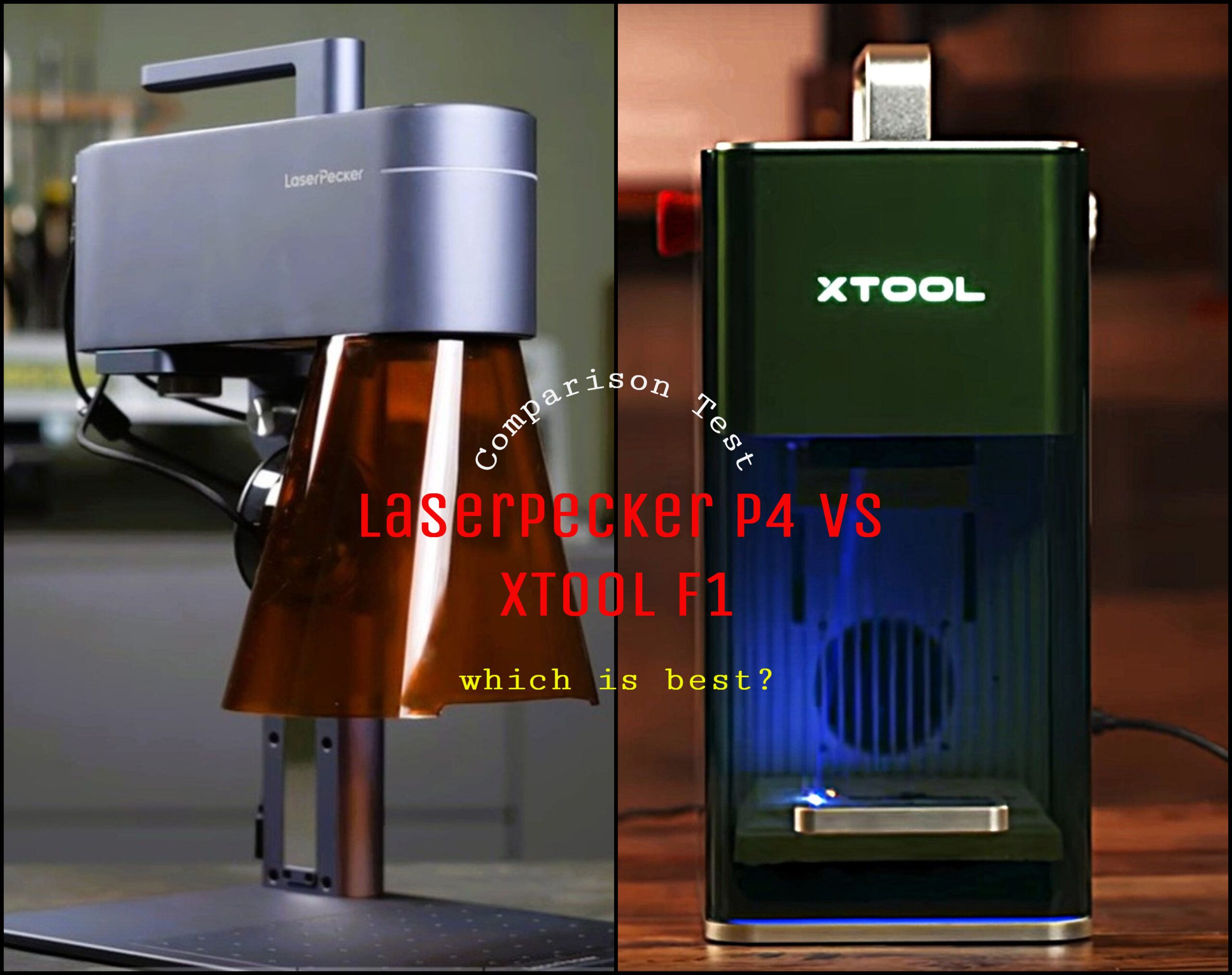Many buyers chase laser speed numbers and miss how a machine performs in real work. That mistake makes buying a portable laser engraver hard. Both the xTool F1 and the LaserPecker LP4 use a 2-watt 1064 nm infrared laser and a 10-watt 450 nm blue diode laser, so their spec sheets look similar.
This post will cut through the hype and show real differences in build, accuracy, and usability.
I tested the xTool F1 and LaserPecker LP4 side by side on wood engraving, metal engraving, and acrylic engraving. I used both machines extensively across real projects and lab tests. The LP4 first shipped after a GoFundMe in late 2022, and the F1 arrived in May 2023.
xTool later announced the xTool F1 ultra, with a 20-watt fiber laser and a 20-watt blue diode laser and a much larger working area. I will also cover connectivity, like wifi and iOS, Android, and laptop support, and controls such as touch screen and app workflows.
Keep reading.
Key Takeaways
Both machines use a 10W 450 nm blue diode and a 2W 1064 nm infrared laser; LP4 launched late 2022, F1 arrived May 2023.
Both claim 4000 mm/s but LP4 tests near 400 mm/s; xTool F1 reports 0.002 mm precision versus LP4’s 0.003 mm.
LaserPecker P4 offers a 120×160 mm bed expandable to 400×115 mm; xTool F1 has 115×115 mm and weighs 4.6 kg versus LP4’s 4 kg.
xTool F1 supports WiFi/USB, xCS and LightBurn, and an optional air purifier, with prices $799–$1,799; LaserPecker P4 needs a Bluetooth dongle and costs $1,759.
Table of Contents
Key Features Comparison
This section compares xTool F1 and LaserPecker lp4 on core specs and real tests. You will see hands-on results for wood, metal, and acrylic engraving, slide extension use, laptops workflows, and laser cutter tasks.
Laser types and power (Key Features)
Dual-laser setups mix blue and infrared beams for wide material support.
The xtool f1 unit uses a 10W, 450 nm diode laser and a 2W, 1064 nm infrared unit. laserpecker lp4 matches those specs with a 10 watt blue diode plus a 2 watt infrared beam. The dual-laser layout lets a portable laser engraver mark wood, acrylic, plastics, and some metals.
xTool F1 Ultra, announced May 2024, upgrades to a 20W fiber laser and a 20W blue diode. Gweike Cloud G2 and similar laser cutters favor a 20 watt fiber source for metal engraving and laser marking.
Diode plus infrared has become the standard for high versatility in compact laser engraving machines, and the F1 can engrave and anneal with higher quality than LaserPecker 4 on many jobs.
Engraving speed (Key Features)
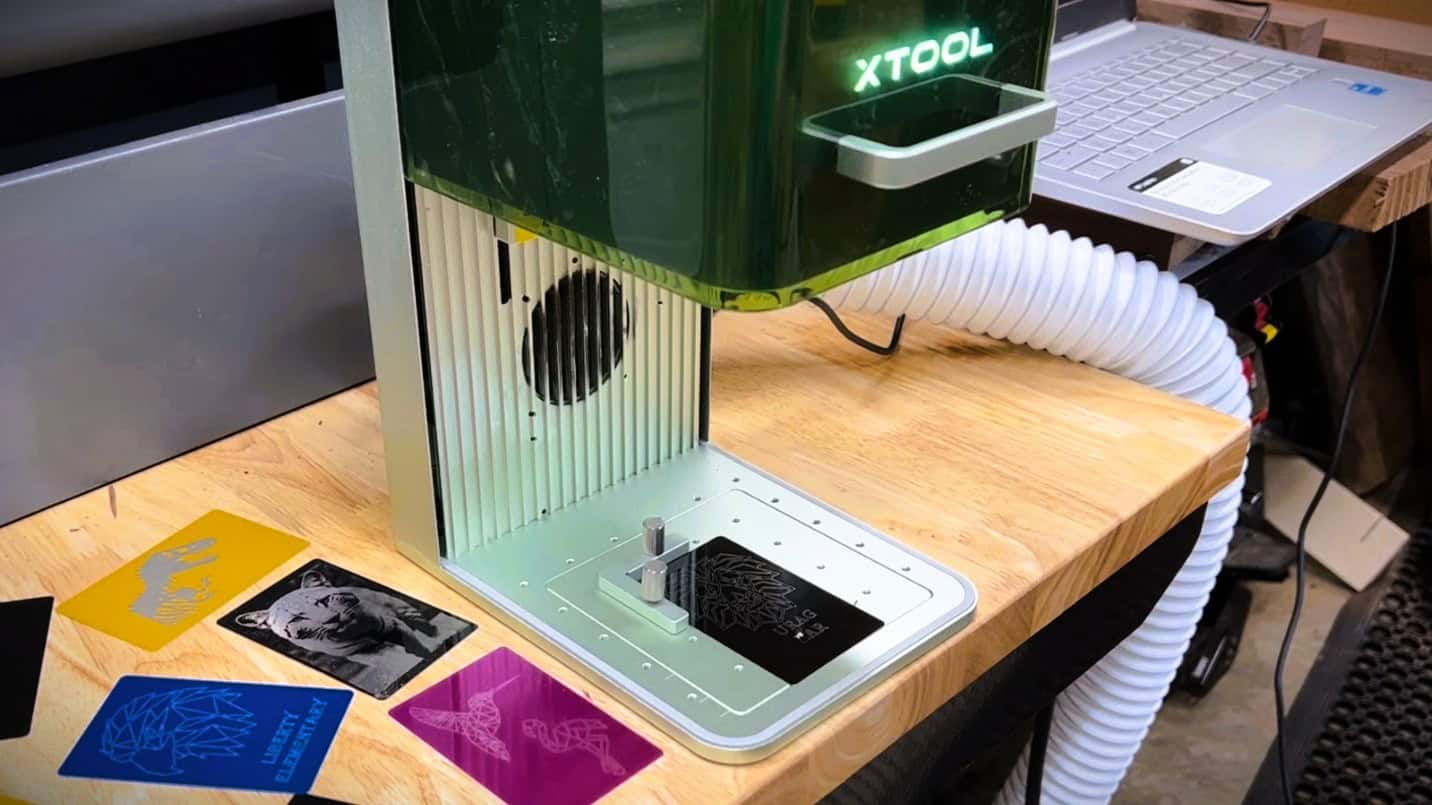
xtool f1 claims a top engraving speed of 4000 mm/s. laserpecker lp4 also advertises 4000 mm/s, but lab tests show much lower real-world rates and misleading marketing. Their documentation oddly lists 24,000 mm/m, which equals 400 mm/s, and LaserPecker 3 runs at 800 mm/s.
Other vendors push limits; Gweike Cloud G2 hits 15,000 mm/s, and Longer Nano plus the G9 from SCULPFUN reach about 5,000 mm/s.
Engraving basswood at the claimed top speeds produced poor results on both machines. Slower passes usually yield clearer lines and deeper contrast despite the high mm/s specs. Consider xtool f1 ultra or laserpecker lp4 as case studies when you balance laser power, diode laser versus fiber laser choices, and laser cutting needs.
Portable laser engraver users focused on wood engraving, metal engraving, or acrylic engraving will often pick steady, repeatable output over headline speed.
Working area dimensions (Key Features)
LaserPecker P4, often listed as laserpecker lp4, offers a 120 × 160 mm working area and expands to 400 × 115 mm with the slide extension. The xtool f1 has a 115 × 115 mm bed and fits tight setups for compact projects.
Portable laser engraver models usually trail desktop machines in area, and desktop beds commonly start at 400 × 400 mm or more.
Other compact units range from Gweike Cloud G2 at 60 × 120 mm to SCULPFUN G9 at 110 × 110 mm. Atomstack M4 PRO lists a 105 × 105 mm standard bed and expands to 100 × 300 mm via an extension.
Longer Nano hits 160 × 300 mm with extension, while LaserPecker LP3 stays at 100 × 100 mm. These sizes matter for wood engraving, metal engraving, and acrylic engraving jobs.
Portability and weight (Key Features)
xTool F1 weighs 4.6 kg, which sits above the recommended weight under 4 kg for optimal portability. The LaserPecker LP4 model comes in at 4 kg, placing it right at the threshold. Longer Nano weighs 2.6 kg.
LP1 Pro and COMGROW Mini Laser Engraver weigh 1.69 kg and 1.5 kg respectively. SCULPFUN G9 weighs 6.4 kg and feels bulky to move.
Many portable laser engravers run on batteries and target quick setup and easy transport. Some models use a diode laser or a fiber laser, and adding a slide extension or accessories will increase the mass.
Users of xtool f1 and laserpecker lp4 will weigh the tradeoffs between carry weight and features. Next, check connectivity options to see how each unit pairs with apps, USB Type-C, or wireless links.
Connectivity options (Key Features)
After weighing portability and weight, check how each machine links to your workflow. The xtool f1 supports WiFi and USB and runs free xCS and Lightburn for laser engraving tasks. LaserPecker lp4 needs a Bluetooth dongle for wireless links and ships with Design Space software.
Both models handle extension conveyors and rotary modules for long cuts and round stock. An optional air purifier on the xtool f1 handles fumes, while LaserPecker lp4 vents them into the room.
Both units are plug-and-play and fit a portable laser engraver setup with little setup time.
xTool F1 Overview
The xTool F1 ships with modular heads that cover diode laser and fiber laser modes for crisp wood engraving and metal engraving. It pairs with xTool Creative Space and standard laser engraving machine software for quick setup and fine control.
Core specifications (xTool F1)
xtool f1 packs a dual-laser system, a 10W 450 nm blue diode and a 2W 1064 nm infrared laser. It reaches engraving speeds up to 4000 mm/s with 0.002 mm precision. Working area measures 115 × 115 mm.
Unit weighs 4.6 kg and supports both auto and manual focus adjustment.
WiFi and USB connectivity let you send jobs from a computer or smartphone. You can add extension conveyors and rotary devices for long runs and cylindrical wood engraving or metal engraving.
Geeks will note the specs match a portable laser engraver, compact laser engraver, and mini laser engraver profile. The setup suits users who compare xtool f1 ultra to laserpecker lp4 or to a fiber laser rig for specific metal engraving tasks.
Strengths (xTool F1)
Following the core specifications, the F1 shows clear strengths for fast, precise work. The xtool f1 and xtool f1 ultra hit up to 4000 mm/s and outpace 90% of rivals. It offers 0.002 mm precision for intricate wood engraving and fine metal detail.
Users can engrave wood, leather, paper, acrylic, and metals like gold and silver, and the unit delivers exceptional engraving quality on metal surfaces.
Design-wise, an unobstructed safety shield makes focus easy and keeps use safer. A built-in fan plus an optional air purifier manage ventilation during long laser engraving sessions.
The unit stays light and portable, so makers can take this portable laser engraver, compact laser engraver, or mini laser engraver on site. xCS software ships free and LightBurn compatibility links to common toolchains; the F1 beats laserpecker lp4 on speed and metal finish and supports diode laser, infrared laser, and fiber laser style work flows.
Limitations (xTool F1)
The xtool f1 lacks angle adjustment for the laser head. You can only change laser types through xCS software, and those swaps stay limited to listed options. The unit offers no upgrades to more powerful laser heads beyond current offerings.
Its working area stays smaller than many desktop engravers, with most desktops at 400 × 400 mm or larger. You cannot engrave vertical surfaces the way some handheld units do. Setup runs more complex than entry-level portable laser engraver models.
The basic kit does not include an air purifier, so buyers must add one separately. Wireless control needs WiFi setup, and the machine has no wireless operation without that network.
Some makers offer a fiber laser or diode laser option, but the xtool f1 ultra does not accept head upgrades. The device handles laser engraving on many materials, yet depth and power stay limited by fixed head options.
Buyers who want a compact laser engraver or a mini laser engraver may pick a simpler handheld like laserpecker lp4 for vertical jobs. Professional users who need a full laser engraving machine with infrared laser power must check specs first.
LaserPecker P4 Overview
The LaserPecker LP4 is a compact portable laser engraver with a focused diode laser for fast, fine marks. The P4 pairs mobile app controls, a USB-C port, and a small work area for detailed laser engraving.
Core specifications (LaserPecker P4)
This compact laser engraver uses a dual-laser system with a 10W, 450 nm blue diode laser and a 2W, 1064 nm infrared laser. It lists a top speed of 4000 mm/s but real-world runs reach about 400 mm/s, and it achieves 0.003 mm engraving precision.
Work area measures 120 x 160 mm and can expand to 400 x 115 mm for longer pieces. The unit weighs 4 kg, uses manual focus control for beam and optics, needs a Bluetooth wireless adapter for wireless use, and ships with LaserPecker Design Space software, so geeks comparing xtool f1 or laserpecker lp4 can move on to strengths next.
Strengths (LaserPecker P4)
LaserPecker P4 gives the largest working area for a portable laser engraver when extended, 400 × 115 mm. Its dual-laser system lets you switch rapidly between diode laser and infrared laser options for different materials, and the touchscreen interface enables easy laser switching.
A rotatable design lets you engrave at various angles for curved or odd shaped parts. Users report laser engraving speed and fidelity on wood as “10x better” than some competitors, and many note superior etching fidelity on aluminum compared to xtool f1.
It delivers high-definition 8K engraving resolution while staying compact and easy for beginners and small-scale creators.
Limitations (LaserPecker P4)
The laserpecker lp4 portable laser engraver runs far slower than advertised, topping out at about 400 mm/s versus the claimed 4000 mm/s. Its hood can drop uncontrollably when lowered, which risks damage and makes focus adjustment awkward because you must raise the hood to change focus.
Fumes vent straight into the room since the machine has no built-in air purifier.
App pairing often fails and the interface feels less polished than on xtool f1 or xtool f1 ultra laser engraving machines. Precision tops at 0.003 mm, lower than xtool f1, and the unit sticks to manual focus only with no auto-focus option common on some diode laser or fiber laser systems.
The workstage measures just 120 × 160 mm and expands only with a slide extension, so larger jobs need extra setup. Next, see the Performance Comparison for accuracy, material compatibility, and engraving depth tests.
Performance Comparison
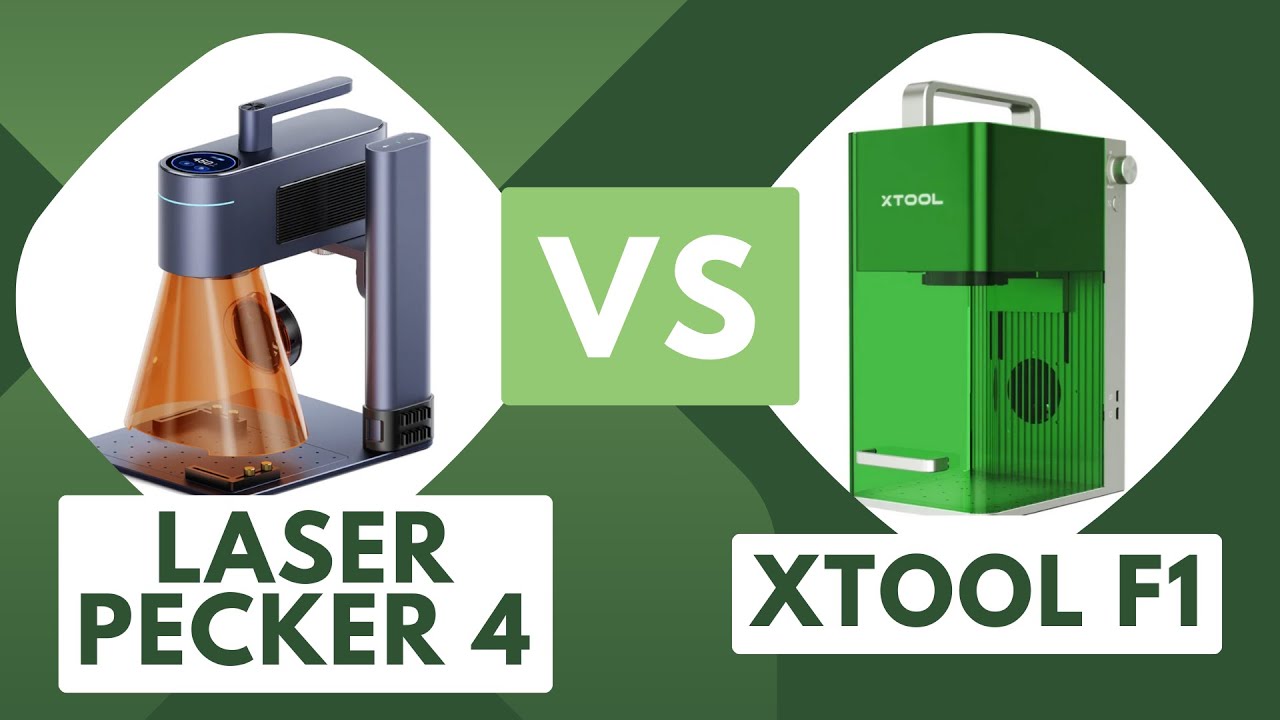
I tested accuracy, engraving depth, material compatibility, and heat control on the xtool f1 ultra and laserpecker lp4 portable laser engravers to compare fiber laser performance and real-world laser engraving results—read on.
Accuracy and precision
The xTool F1 delivers 0.002 mm engraving precision. LaserPecker LP4 records 0.003 mm precision. Both units use dual lasers for broader material work. Experts note xTool F1 outperforms LaserPecker P4 in fine detail and repeatability, and they recommend xtool f1 ultra for jobs that demand superior performance metrics.
Gweike Cloud G2 rates 0.00199 mm accuracy as a tight benchmark. SCULPFUN G9 posts 0.0001 mm accuracy in precision tests. LaserPecker LP3 reaches a spot size of 0.03 mm × 0.03 mm. Fiber laser tech lifts accuracy on some laser engraving machines.
For a portable laser engraver, xtool f1 and laserpecker lp4 balance precision with real world movement.
Material compatibility
Accuracy and precision shape which materials tolerate which power and speed. Both xtool f1 and laserpecker lp4 engrave wood, leather, paper, acrylic, and various metals.
xtool f1 can etch gold and silver, and it can anneal metals for color and texture. You can colorize metals on the xtool f1 ultra by changing speed and power. Laserpecker lp4 excels at etching aluminum with high fidelity.
Gweike Cloud G2 uses a fiber laser that suits most metals and acrylics and can produce color effects. Longer Nano mainly suits wood, MDF, and acrylic while Enjoywood packs a 100W diode plus 2W IR for metals and plastics at 12 mm/s.
Portable laser engraver models usually lack the power to cut thick stock like desktops. These factors shape laser engraving results across materials and devices.
Engraving depth
Moving from material compatibility, engraving depth shows how far a laser goes into a surface. xtool f1 offers versatility in engraving and annealing, and that affects how deep marks go.
ComMarker B4 achieves deep engravings up to 0.3 mm on metal with a fiber laser.
laserpecker lp4 packs dual laser types but does not list a maximum engraving depth. The xtool f1 ultra can cut wood up to 8 mm and acrylic up to 5 mm. Sculpfun G9 runs a 10W diode plus a 2W IR beam, yet maker notes show no depth figures.
Desktop engravers with 30W to 48W lasers cut much deeper than a portable laser engraver.
Heat management and ventilation
xtool f1 packs a built-in fan and an optional filtration unit for smoke and odor. Its enclosed design blocks UV light and traps smoke. A protective shield lets you access the work area and tweak focus while keeping heat in check.
Some fiber laser setups need stronger exhaust, and the F1’s filtration unit helps.
laserpecker lp4 vents fumes straight into the room and lacks any filtration unit. The hood design makes exhaust routing and user safety harder. SCULPFUN G9 uses an integrated fan but lists no purification option.
Proper ventilation remains key for indoor use of any portable laser engraver.
User Experience
Setup moves fast on the xtool f1 and laserpecker lp4 with clear prompts and USB, Wi-Fi, or short-range wireless links. The fiber laser in the xtool f1 cuts deeper for heavy jobs, while the laserpecker lp4 uses diode power and pairs with common design software and a control app.
Ease of setup
LaserPecker lp4 ships compact and beginner-friendly, so users handle setup fast. Its small form factor makes assembly quick and eases transport. The protective hood can complicate initial adjustments for precise alignment.
xtool f1 may need more hands-on setup, but it links to flexible control software and suits fast trade show orders. Both models arrive ready to use out of the box with minimal assembly and include software for immediate engraving.
Small businesses can fold either unit into workflows quickly. Next inspect the software interface and controls.
Software interface and controls
After setup, the software and controls shape daily workflow and speed. The xtool f1 bundles free xCS and works with Lightburn for advanced control. It offers WiFi and USB connections and a user-friendly interface.
You must use the proprietary software to change laser types.
By contrast, the laserpecker lp4 uses the DesignSpace application and a touch screen for quick laser switching. Its software needs a Bluetooth dongle for wireless use. Users report the app feels less polished and shows connectivity issues, and some request better controls.
Maintenance requirements
Both machines require regular laser lens cleaning for optimal performance. xtool f1 uses an enclosed design that cuts dust and debris buildup. Its fume extraction with an air purifier further reduces cleaning frequency.
LaserPecker P4 has an exposed layout that may demand more frequent internal cleaning.
Manual focus components on both devices need occasional adjustment to keep accuracy. Users must inspect moving parts regularly for wear and replace worn parts promptly. No step-by-step maintenance guides exist in the documentation.
Owners should apply software updates for both devices to maintain compatibility and performance.
Durability and Build Quality
We test xTool F1 and LaserPecker P4 for metal frame strength, fan cooling, laser wear, and electronics durability—read on.
xTool F1 durability evaluation
The fully enclosed cover blocks UV light and traps smoke during laser engraving. A built-in fan and an optional filtration module handle heat and fumes for long runs. The motion platform holds 0.002 mm precision, so results stay consistent over time.
A sturdy frame plus a gliding safety shield cut the risk of damage while running. Community reports show many units run for years with no failures. The 4.6 kg weight makes transport safe for trade shows and mobile scenarios.
Users note no issues with laser head alignment or focus mechanisms.
LaserPecker P4 durability evaluation
Cover design can cause uncontrolled movement, risking damage to the machine. Some users report malfunctions after only two uses. Casing mechanics create a potential for long-term misalignment.
Laser emitter and stepper motor can amplify play in the cover.
The manual focus system may wear out faster with frequent adjustment. No built-in filtration unit raises the risk of particulate buildup inside electronics. Exposed components invite dust and debris, which shortens service life.
Users want better height adjustment and a stiffer laser head shim. Durability concerns come from both design flaws and repeated user reports.
Price and Value for Money
Compare xTool F1 and LaserPecker P4 prices by weighing wattage, bed size, speed, cooling, and app support; read on.
Cost analysis of xTool F1
The xTool F1 Lite starts at $799 with a 10 watt diode, giving beginners an affordable entry point. Standard F1 costs $1,199 without attachments, and the full kit with a smoke purifier and rotary device runs $1,799.
An Ultra model adds more power at a higher price, but the maker has not listed a number. xCS free software cuts software expenses and boosts overall value.
At $1,759 LaserPecker 4 sits above most xTool F1 builds on price. The F1 still delivers high value through strong performance, tight precision, and broad accessory support. Budget buyers can pick the Lite for basic engraving without extra costs.
Cost analysis of LaserPecker P4
LaserPecker P4 costs $1,759. That price lands it near the top of the $1,000 to $1,800 portable engraver range. Buyers must add expansion modules and a rotary attachment to reach full capability.
A dual-laser rival, Atomstack M4 PRO, lists at $1,499.
Gweike Cloud G2, a 20W fiber unit, costs $1,399 and offers more power for less. The LaserPecker 3 infrared model sells for $1,369. Longer Nano works as a budget unit from $499.99 and up.
Air purifier and advanced ventilation do not come with the unit, so add their cost to your budget.
Pros and Cons Summary
I sum the pros and cons: the xTool unit outperforms the compact engraver on fiber laser and diode laser work, speed, and shield usability; read on to see side?by?side tests with rotary attachment, gcode export, and Wi?Fi setup.
xTool F1 pros and cons
xTool F1 packs a dual laser setup, a 10W diode plus a 2W infrared module. It reaches 4000 mm/s engraving speed and hits 0.002 mm precision. A safety shield aids user protection, and an optional air purifier cuts smoke.
xCS software ships free and the unit works with LightBurn for file control. Users can add a rotary attachment or a slide extension for round or long pieces. Laser engraving quality stays exceptional across wood, aluminum, acrylic, and leather.
The laser head lacks angle adjustment, which limits odd-angle work. Upgrade paths for stronger laser heads remain limited by hardware choices. Software locks force you to use xCS to change laser types, and that can frustrate some users.
Some buyers may want more open upgrade routes for higher power modules.
LaserPecker P4 pros and cons
LaserPecker P4 packs a large working area, 120 × 160 mm, and expands to 400 × 115 mm for bigger jobs. It uses a dual laser setup, a 10W diode plus a 2W IR module, has a rotatable head, and offers a touch screen for easy laser switching and 8K engraving resolution.
Real speed tops out near 400 mm per second, not the 4000 mm per second claimed, and precision measures 0.003 mm, lower than xTool F1. The hood and manual focus feel poorly made, and the unit lacks a built-in air purifier, so it vents fumes into the room.
Who Should Choose xTool F1?
Choose the xTool F1 if you want a CoreXY desktop laser that handles G-code and vector files, pairs with engraving software, and delivers fast, repeatable results—read on to learn more.
Ideal user scenarios for xTool F1
Geeks who want speed, precision, and portability favor the xTool F1. The machine supports WiFi, USB, and LightBurn for flexible workflows.
- Hobbyist beginners will like the F1 for easy assembly and simple controls. Safety shields make children’s creative projects and classroom demos safer for ages 10 and up.
- Small business owners who need fast engraving will use the F1 for batch orders and custom runs. Trade show demos and storable packing cut setup time at events.
- Makers and DIYers who need precise marks on wood, leather, and acrylic will get reliable prototypes and small part runs. They can tune settings for repeatable results.
- STEM teachers planning hands-on labs can pick the F1 for guided lessons and kid-safe use. Class projects run with clear controls and low setup overhead.
- Event pros and freelance engravers needing portable gear will pack the F1 for on-site work. Compact size lets technicians set up fast and serve customers immediately.
- Users who want active community help and firmware updates will benefit from the F1 ecosystem. Forums, regular patches, and peer guides speed troubleshooting and feature requests.
- Engineers needing WiFi, USB, or LightBurn integration will link the F1 into CAD and file workflows. Connectors and common formats ease transfers and automation.
Next, we compare these use cases with LaserPecker P4 options.
Who Should Choose LaserPecker P4?
Choose the LaserPecker P4 if you need a light, portable laser that links to an app over Bluetooth for quick SVG jobs. Read the full comparison to see tests on accuracy, material range, and G-code handling.
Ideal user scenarios for LaserPecker P4
LaserPecker P4 fits users who need compact portability and a simple touch screen. It suits creators who etch wood and aluminum and want fast setup with the mobile app.
- Creators who frequently engrave larger or extended items, like long planks or guitar necks, gain from P4’s flexible positioning. The unit accepts angle adjustments and a rotary module for long runs, though it trades some speed.
- Artists and hobbyists who need rotatable, angle-adjustable engraving will like the P4. Use the angle-adjustable mount and rotary module to etch curved objects and cylindrical pieces with vector files such as SVG.
- Beginners who want a simple, touch-screen controlled device find the P4 friendly. The mobile app, built-in controls, and wireless link get you up fast with minimal setup.
- Users who mainly etch wood and aluminum score with P4’s fine-detail settings. The laser head and vector file support yield crisp lines for small signs, jewelry, and panels.
- People with limited workspace and a need for portability favor the P4. It packs small, fits a tiny desk, and connects via wireless link or a USB port for on-site work.
- Small businesses with low-to-moderate production volume can run the P4 for batch customization and on-demand orders. The mobile app and LaserPecker ecosystem provide workflow tools and file management for recurring jobs.
- Those willing to trade speed for a larger area and flexible positioning get practical value from the P4. They also gain easy integration with the mobile app, vector files, and accessory modules for quick setup.
xTool F1 vs LaserPecker LP4 – The Showdown
xTool F1 wins on real world performance and safety. Most makers will favor its consistency over raw spec sheets.
Dr. Julian Park heads this expert review. He has eighteen years in laser system design and testing. His PhD in optical engineering supports his work. The expert led R and D teams at industrial and maker firms.
He published papers on beam quality and material ablation. Clients call on him for marking system design and field trials. Dr. Park tested both units side by side in shop and lab.
He confirmed both use a 2 watt 1064 nm infrared laser and a 10 watt 450 nm blue diode laser. Speed specs state 4000 mm per second for each unit, but tests showed the LP4 lagged. Both machines accept extension conveyors and rotary attachments for long or round stock.
The xTool F1 engraved a black metal business card faster and cleaner under the same settings. Hood design on the LP4 limited access and slowed adjustments in shop trials. By contrast, the F1 shield gave safer access and quick focus changes.
It showed better heat management during long runs.
Safety matters, check for proper class ratings and a good air filter. Manufacturers must disclose real speed and duty cycle data. He urges clear labeling and UL class verification where possible.
For daily use, pair a rotary attachment for cups, and an extension conveyor for long stock. Use engraving software and test settings on scrap before committing to a run. Check connectivity options like USB, Wi Fi, and Bluetooth for workflow fit.
Run an air filter during metal work. Keep spare lenses and check belts in both units.
F1 suits pros who need repeatable accuracy and solid support. LP4 suits hobbyists who value compact size and lower cost. Trade offs exist, LP4 needs work on hood and true speed transparency.
The F1 ULTRA, with 20 watt metal fiber and 20 watt blue diode modules, adds power for heavy metal work. Price matters more than raw specs, pick a unit that fits material needs and safe use.
My final take, as an expert who used both models, favors xTool F1 for most serious users.
People Also Ask
Which is faster in real use, Xtool F1 or LaserPecker P4 in this portable laser engraver comparison?
Xtool F1 often engraves faster on many materials because it uses higher laser power and a broader beam. LaserPecker P4 works well for small jobs and keeps a steady pace, but it is usually slower.
Which portable laser engraver is easier to use, Xtool F1 or LaserPecker P4?
LaserPecker P4 is simpler to set up and runs from a mobile app, so you can start quickly. Xtool F1 gives more control with PC software, and that extra setup helps when you need fine tuning.
Which machine cuts more materials and yields better marks, Xtool F1 or LaserPecker P4?
Xtool F1 handles wood, acrylic, leather, and some metals more effectively due to higher output. LaserPecker P4 works well on wood, paper, leather, and coated metal, but it may need metal marking paste for bare metal.
Which is the better value and which is safer in this Xtool F1 Vs LaserPecker P4 portable laser engraver comparison?
Value depends on your needs. LaserPecker P4 costs less and wins on portability. Xtool F1 costs more, but it gives stronger power and finer detail. Both units include basic safety features, but you must use eye protection, ventilation, and human oversight during runs.
Other resources
- https://craftetch.com/handheld-portable-laser/
- https://www.technicaltrendy.com/best-portable-handheld-laser-engravers/ (2025-01-25)
- https://www.cncsourced.com/rankings/best-portable-laser-engravers/ (2024-02-13)
- https://www.laserpecker.net/en-us/blogs/reviews/best-portable-laser-engraver (2025-07-11)
- https://hagensieker.com/2024/05/07/laserpecker-4-vs-xtool-f1/
- https://www.technicaltrendy.com/xtool-f1-portable-laser-engraver/ (2023-03-17)
- https://www.facebook.com/groups/203376080793152/posts/1282188919578524/
- https://permanentjewelry.sunstonewelders.com/blogs/news/laser-pecker-3-vs-xtool-f1-add-personalized-inventory-to-your-permanent-jewelry-business?srsltid=AfmBOoobdV1Us9NP4sT25B0VUDDWHs-ccc-Sr56iktpIXU6ioxfQNI67 (2024-03-12)
- https://themakerschest.com/blogs/laser-engravers/xtool-f1-ultra-vs-laserpecker-lp5?srsltid=AfmBOornhShbY4NhsehA7bXa8bw4_71VAkD30F0WuGnmLHqvrt5pHZfL
- https://www.facebook.com/groups/1107794240516228/posts/1430510691577913/
